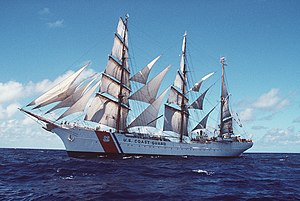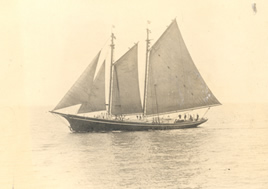United States Coast Guard Academy: Difference between revisions
m updating template parameters... |
|||
| Line 1: | Line 1: | ||
{{Infobox_University |
{{Infobox_University |
||
|name = United States Coast Guard Academy |
|name = United States Coast Guard Academy |
||
| |
|image_name = Coast Guard Academy seal.png |
||
|motto = Scientiæ cedit mare <br /> (''The sea yields to knowledge'') |
|motto = Scientiæ cedit mare <br /> (''The sea yields to knowledge'') |
||
|established = 1876/1915 |
|established = 1876/1915 |
||
Revision as of 08:54, 31 December 2006
 | |
| Motto | Scientiæ cedit mare (The sea yields to knowledge) |
|---|---|
| Type | Federal military academy |
| Established | 1876/1915 |
| Superintendent | Rear Admiral James C. Van Sice |
| Undergraduates | 990 |
| Location | , , |
| Nickname | Bears |
| Mascot | Objee the Bear |
| Website | www.uscga.edu |
The United States Coast Guard Academy (USCGA), located in New London, Connecticut (41°22′22″N 72°06′06″W / 41.37278°N 72.10167°W), is a U.S. military academy that provides education to future officers of the United States Coast Guard.
Description

Unlike the other Service Academies, admission to the Coast Guard Academy is purely merit-based, and does not require a Congressional nomination.[1] The Academy is regularly cited as being the most difficult U.S. college-level institution to gain entrance into. Each year some 400 students are selected from an applicant pool about eight times that size for appointments to the Academy. About 280 of those 400 students accept the appointment and report to the USCGA in early July for "swab summer," a basic military training program designed to prepare them for the rigors of their Fourth Class year. Each cadet takes two semesters of classes during the school year and then spends the majority of the summer in military training. After four years of study and training, approximately 175 cadets will graduate with a B.S. degree and be commissioned as Ensigns in the United States Coast Guard, to begin serving their five years of obligatory duty. Around 30% of the Corps of Cadets is female.
Mission
While Superintendent of the Coast Guard Academy, in 1929 Vice Admiral Harry G. Hamlet composed the Academy's mission statement. All entering cadets must memorize the mission during their first few days of Swab Summer, the indoctrination period for new cadets.
The mission of the United States Coast Guard Academy is to graduate young men and women with sound bodies, stout hearts and alert minds, with a liking for the sea and its lore, and with that high sense of Honor, Loyalty and Obedience which goes with trained initiative and leadership; well-grounded in seamanship, the sciences and the amenities, and strong in the resolve to be worthy of the traditions of commissioned officers in the United States Coast Guard, in service to their country and humanity.[2]
Course of study

Because all cadets earn a Bachelor of Science degree and become a commissioned officer, the Coast Guard Academy maintains a core curriculum of science and professional development classes in addition to major-specific classes. Additional military training is interspersed with schoolwork in order to produce officers of character with the requisite professional skills. Among these are classes in leadership, ethics, organizational behavior, and Nautical Science. Because the vast majority of all cadets report as Deck Watch Officers upon graduation, these Nautical Science courses help every cadet master piloting, voyage planning, deck seamanship, and all aspects of ship-handling.
Academic majors
Academics at the Coast Guard Academy stress the sciences and engineering, but many different courses of study are available. In addition, several of the majors offer tracks of specialization (for example, Marine and Evironmental Science majors can choose to focus on biology, chemistry, or geophysics). Cadets sometimes opt to take elective classes across the road as part of an open exchange agreement with Connecticut College.
The Academy offers eight majors:[3]
- Civil Engineering
- Mechanical Engineering
- Electrical Engineering
- Naval Architecture and Marine Engineering
- Operations Research and Computer Analysis
- Marine and Environmental Sciences
- Government
- Management
Military training

Each summer, cadets participate in training programs depending on their class. The summers are organized as follows:[4]
- Swab Summer: the new class of freshmen report in to the Academy, and are sworn in to the military. They undergo a seven week basic training program which culminates on a week-long voyage underway on the USCGC Eagle, the Coast Guard Academy's training tall-ship.
- Third-class (3/c) Summer: 5 weeks aboard the USCGC Eagle training under sail, 5 weeks aboard an operational Coast Guard Cutter in the role of junior enlisted (standing watches as helmsman, lookout, and quartermaster of the watch).
- Second-class (2/c) Summer: Damage Control training, weapon qualifications, navigation rules certification, aviation internship, sail training program, and 3 weeks as Cadre training the incoming Swabs.
- First-class (1/c) Summer: 10 weeks aboard an operational Cutter in the role of a junior officer (standing bridge watches conning the ship as Officer of the Deck).
Every week during the school year cadets participate in Regimental Review, a formal drill. In addition, cadets stand duty at the Academy in a variety of different roles. Like all cadets and midshipmen at one of the United States Service Academies, Coast Guard cadets wear uniforms at all times and are considered to be Active Duty military. Cadets receive a monthly stipend to pay for books, uniforms, and other necessities.
Organization of the Corps of Cadets
The Corps is organized as one Regiment divided into eight Companies, each of which is composed of about 120 cadets of all classes. Although the Corps of Cadets is supervised directly by the Commandant of Cadets (a Captain) and the Assistant Commandant of Cadets (a Commander), the Coast Guard Academy operates on the concept of "the Corps leading the Corps."
The highest-ranking cadet in each Company is the Company Commander, a First Class cadet – or "firstie." Although each company has some leeway in their standards and practices, every Company Commander reports to Regimental Staff who plan and oversee all aspects of cadet life. At the top of the cadet chain of command is the Regimental Commander, the highest ranking cadet. Command positions, both in Companies and on Regimental Staff, are highly competitive, and a cadet’s overall class rank is often a deciding factor in who is awarded the position.
Each of the eight Companies – named Alpha through Hotel in the military phonetic alphabet – has a special focus in administering day-to-day affairs; for instance, Charlie Company is in charge of Honor Administration, Delta Company is in charge of Drill and Ceremonies, Hotel Company is in charge of Morale Events, and so forth. To accomplish these missions, each company is broken down into three Departments and further into a variety Divisions. Divisions are the most basic unit at the Coast Guard Academy, and each has a very specific duty. Each division is commanded by a Firstie and contains several members of each other class.
This organizational structure is designed to give every cadet a position of leadership and to emulate the structure of a Coast Guard Cutter, in which the Division Officer and Department Head positions are filled by junior officers. Third-class cadets directly mentor the Fourth-class in their division, just as a junior enlisted would be responsible for a non-rate. Second-class cadets act as NCO's, and ensure that the regulations and accountability are upheld. Firsties are in supervisory roles, and are responsible for carrying out the mission of their Division and ensuring the well-being of the cadets in their command, just like a junior officer.
History

The roots of the academy lie in the School of Instruction of the Revenue Cutter Service which was started near New Bedford, Massachusetts in 1876, using the Revenue Cutter Dobbin for its exercises. With changes to new training vessels, the school moved to Curtis Bay, Maryland in 1900 and then again in 1910 to Fort Trumbull, a Revolutionary War army installation near New London, Connecticut.
The modern academy dates to the 1915 merger of the Revenue Cutter Service and several other marine services which formed the modern Coast Guard. The town of New London donated its current location above the west bank of the Thames River in 1932. In 1947, the academy received as a war reparation the German barque Horst Wessel, a magnificent 295 foot "tall ship". It was renamed the USCGC Eagle, and it serves as the main training vessel for academy cadets and Officer Candidates.
Extracurricular activities
The USCGA Athletic Department offers 23 intercollegiate sports for cadets, and competes in Division III of the National Collegiate Athletic Association, with the exception of the Rifle and Pistol teams, which compete in Division I. Cadets devote two hours per academic day to athletic activities, either on varsity teams, club teams, or other sports pursuits. The academy nickname is the Bears, after the mascot Objee the Bear.
Recently, the Coast Guard Academy Men's Rugby team won the 2006 Division II National Championship in Stanford, California after an intense match against the University of Northern Colorado.
Non-athletic activities also abound. Principle among them are the musical activities, centered around Leamy Hall. Regimental Band, Windjammers Drum & Bugle Corps, various pep bands, and the NiteCaps Jazz Band are some of the instrumental programs. Chapel Choirs, Glee Club, the Icebreakers all-female a cappella group, and The Idlers all-male sea shanty group are some of the vocal programs.
Notable Graduates
G. William Miller (1925-2006), Class of 1945, who served as chairman of the Federal Reserve Board 1978-79 and secretary of the Treasury from 1979-1981.
Bruce E. Melnick, Class of 1972, was the first Coast Guard officer selected as an astronaut.
Daniel C. Burbank, Class of 1985, became the second Coast Guard astronaut in 1996.
ADM Thad Allen, Class of 1971, currently serving as Commandant of the Coast Guard.
Stephen Flynn, Author, Chair at the Council on Foreign Relations
ADM James Loy, Former Under Secretary for DHS, Commandant
Ellsworth Price Bertholf, First Commandant of the U.S. Coast Guard
External links
- United States Coast Guard Academy Official Website
- United States Coast Guard Academy Alumni Association Website
- Coast Guard Academy Parents Association Website
- Coast Guard Academy Hockey Team Website
References
- ^ United States Code, Title 14, Section 182 (2002).
- ^ Cadet Mission Statement, United States Coast Guard Academy.
- ^ Academics, United States Coast Guard Academy.
- ^ Cadet Life: Summer Training, United States Coast Guard Academy.
